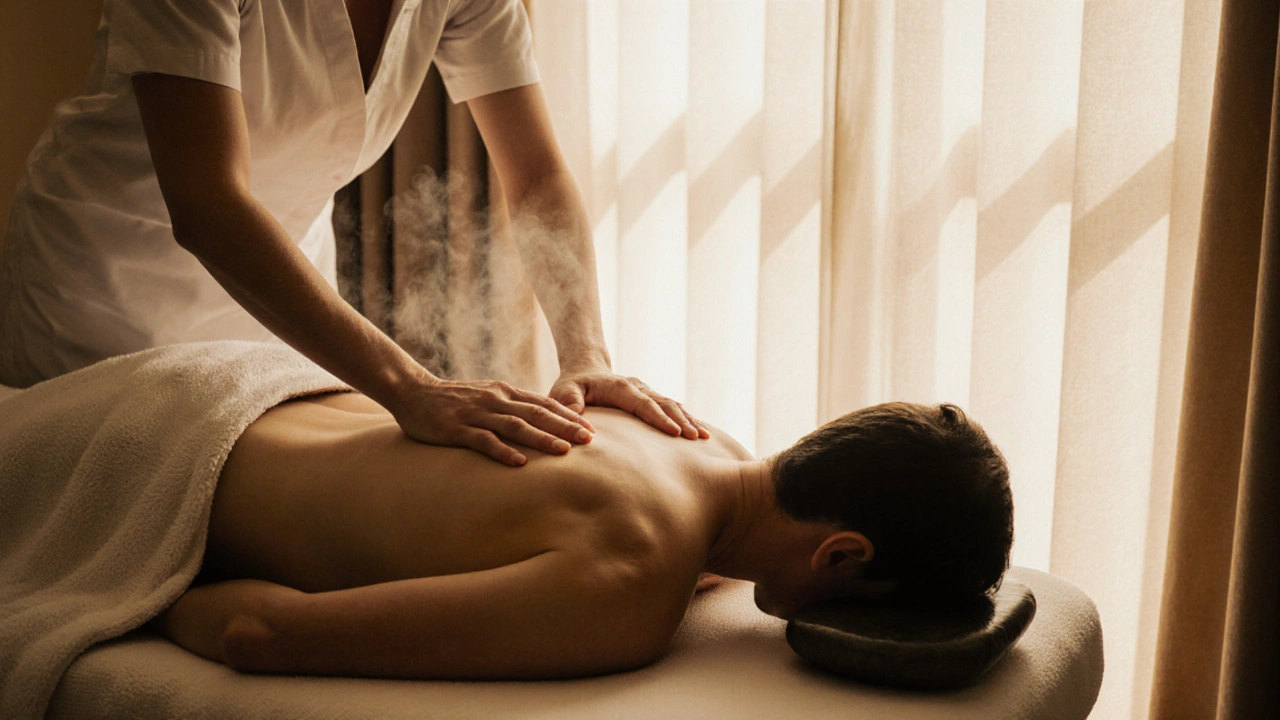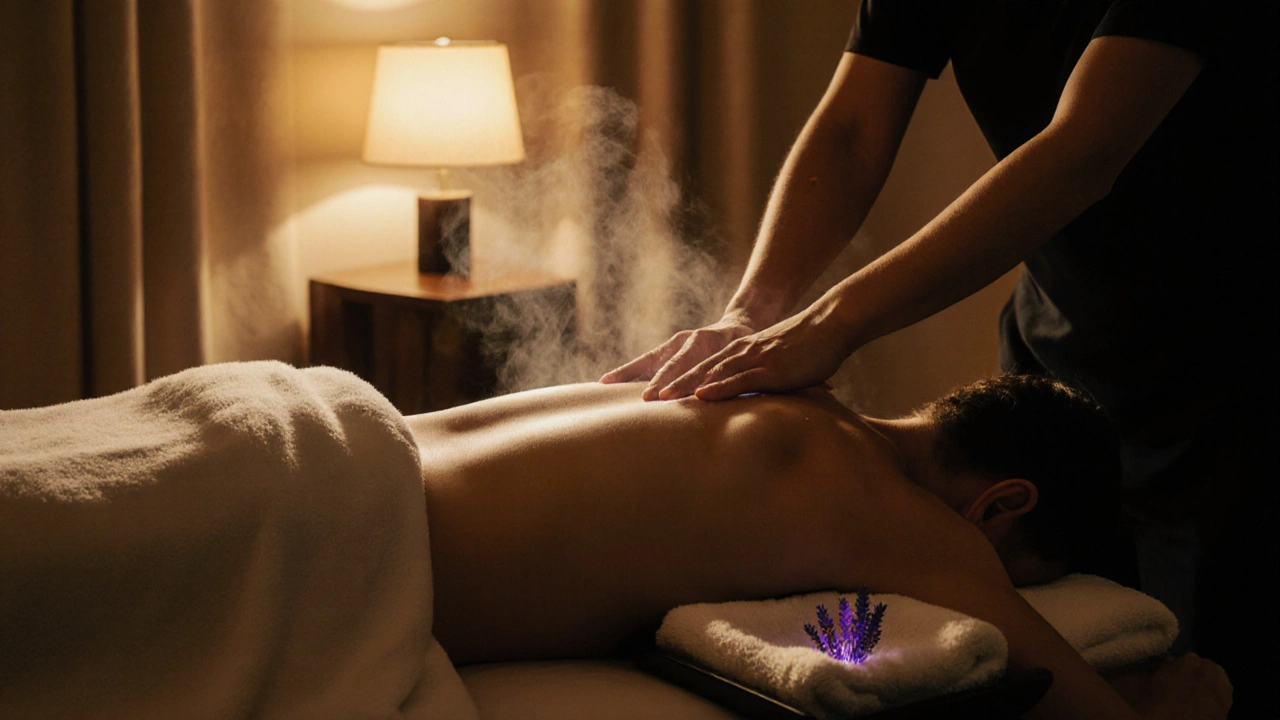Discover the real science behind Swedish massage-how it lowers stress hormones, boosts circulation, and rewires your nervous system for deep relaxation. No fluff, just facts.

- Created by: Archer Caldwell
- Completed on: 19 Nov 2025
- Categories: Full Body Massage
You’ve probably felt it-waking up stiff, struggling to reach for your coffee cup, or noticing your hips won’t twist like they used to. It’s not just aging. It’s tension. Tight muscles, scar tissue, and years of sitting at desks or scrolling on phones have locked your body into patterns that limit how you move. And here’s the thing: full body massage isn’t just about relaxation. It’s one of the most effective, natural ways to regain freedom in your movement.
What Full Body Massage Actually Does for Your Body
A full body massage isn’t just a long, soothing session where you zone out to calming music. It’s a targeted reset for your entire muscular and connective tissue system. Therapists work on every major muscle group-from your scalp to your soles-using techniques that release adhesions, improve circulation, and reset your nervous system.
Think of your muscles like old ropes. Over time, they get knotted and stiff. Massage doesn’t just rub them-it gently untangles them. This releases tension that’s been pulling your joints out of alignment. When your hamstrings loosen, your lower back stops screaming. When your shoulders relax, your neck stops aching. And when your hips open up? Suddenly, bending over to tie your shoes doesn’t feel like a workout.
Studies show that regular full body massage increases range of motion by up to 25% in just four weeks. That’s not magic. It’s science. The pressure and movement stimulate blood flow, flush out lactic acid and metabolic waste, and trigger the parasympathetic nervous system-the part of your body that says, “It’s safe to relax now.”
Why Flexibility and Mobility Are Different (And Why Both Matter)
Flexibility is how far a muscle can stretch. Mobility is how well a joint can move through its full range-with control. You can be flexible but still stiff. Think of a yoga teacher who can touch their toes but can’t squat without their knees caving in. That’s a mobility issue.
Full body massage tackles both. It lengthens tight muscles (flexibility) while also breaking up fascial restrictions around joints (mobility). Fascia is that web-like tissue that wraps around every muscle, bone, and organ. When it gets sticky from inactivity or injury, your movements become jerky and restricted. Massage rehydrates and glides the fascia so your body moves like it’s supposed to-smoothly.
Try this: After a session, stand up slowly. Notice how your spine feels lighter. How your shoulders drop. How your hips swing more naturally when you walk. That’s mobility returning. And it lasts. Not just for a day. For weeks-if you keep it up.
What Happens During a Full Body Massage Session
Most sessions last 60 to 90 minutes. You’ll lie on a warm table, covered with towels. The therapist will start with your back-where most tension hides. They’ll use long, flowing strokes to warm the tissue, then deeper pressure to target knots. Don’t expect it to be painful. It should feel like a good kind of ache-the kind that makes you sigh.
They’ll move to your legs, glutes, and feet. Then your arms, shoulders, neck, and head. Some therapists include gentle joint mobilizations-slow, controlled movements to help your hips and shoulders move more freely. You might hear a soft pop or two. That’s not bones cracking. It’s gas bubbles releasing in the joint fluid. Totally normal.
You’ll be asked to breathe deeply. This isn’t just for relaxation. Deep breathing helps your muscles relax more fully, letting the therapist work deeper without resistance. And yes, you’ll be covered at all times. No awkwardness. Just calm.
Types of Full Body Massage That Boost Mobility
Not all full body massages are the same. If you’re after flexibility and mobility, choose one of these:
- Swedish Massage - Gentle, rhythmic strokes. Great for beginners. Improves circulation and eases general stiffness.
- Deep Tissue Massage - Slower, focused pressure on deeper muscle layers. Ideal if you have chronic tightness in your back, hips, or shoulders.
- Myofascial Release - Targets the fascia. Therapists use sustained pressure or slow stretching to release stuck tissue. Highly effective for mobility.
- Thai Massage - Done on a mat, fully clothed. The therapist uses their hands, elbows, and feet to guide you through yoga-like stretches. Excellent for opening hips and spine.
- Trigger Point Therapy - Focuses on specific knots that refer pain elsewhere. Great if you have tight hamstrings that make your knees hurt.
If you’re new to massage, start with Swedish. If you’ve been dealing with stiffness for years, go for deep tissue or myofascial release. Thai massage is a great option if you like movement-based therapy.

How to Find the Right Massage Therapist in London
London has hundreds of massage studios. But not all therapists know how to work on mobility. Look for these signs:
- They ask about your movement goals-not just “Where do you hurt?”
- They check your posture or ask you to move a limb before starting.
- They mention fascia, joint mobility, or range of motion in their description.
- They’re certified in myofascial release, sports massage, or orthopedic massage.
Check reviews on Google or Trustpilot. Look for phrases like “I can finally bend over again” or “My hips haven’t felt this loose in years.” Avoid places that only advertise “romantic” or “erotic” services. You want a clinical, results-focused approach.
Some clinics in Soho, Camden, and Islington specialize in mobility-focused massage. Ask if they offer a free 10-minute consultation. A good therapist will listen before they touch.
What to Expect After Your First Session
Right after? You’ll feel relaxed. Maybe even a little floaty. That’s normal.
Within 24 hours, you might feel a bit sore-like after a good workout. That’s your body releasing toxins and repairing tissue. Drink water. Move gently. Don’t sit for hours.
By day three or four, you’ll notice changes. Your shoulders won’t feel like they’re hunched up to your ears. You’ll stand taller. Walking downstairs won’t make your knees protest. You might even catch yourself stretching without thinking.
Most people feel the biggest shift after 3-4 sessions spaced a week apart. That’s when the body starts to “remember” how to move freely.
Cost and Booking in London
Prices vary by location and therapist experience. Here’s what you’ll typically pay:
- 60-minute session: £60-£85
- 90-minute session: £90-£130
- Specialist clinics (myofascial or sports focus): £100-£150
Many places offer package deals-three sessions for the price of two. That’s the smart way to start. Consistency matters more than one-off treatments.
Book online. Most studios let you choose your therapist, session length, and even preferred pressure level. Don’t be shy about asking if they’ve worked with clients who had mobility issues. Good therapists love that question.

When to Avoid Full Body Massage
Massage is safe for most people. But skip it if you have:
- An active infection or fever
- Recent surgery or open wounds
- Severe osteoporosis (unless cleared by your doctor)
- Deep vein thrombosis (blood clots)
If you’re pregnant, let your therapist know. Many offer prenatal massage with special positioning. And if you’re on blood thinners, ask for lighter pressure.
Full Body Massage vs. Stretching or Yoga for Mobility
| Aspect | Full Body Massage | Stretching or Yoga |
|---|---|---|
| Primary Goal | Release deep tissue tension and fascial restrictions | Improve muscle length and joint control |
| Who Does the Work | Therapist | You |
| Speed of Results | Noticeable after 1-3 sessions | Takes weeks to months of consistent practice |
| Best For | Chronic tightness, injury recovery, stuck joints | Maintaining flexibility, building strength, daily routine |
| Cost | £60-£150 per session | Free (home) to £20-£40 per class |
| Long-Term Maintenance | Monthly sessions | Daily practice |
Massage doesn’t replace stretching. It makes it easier. Think of massage as clearing the road. Stretching is driving on it. You can’t drive well if the road is blocked by rocks. Massage removes the rocks. Then stretching helps you drive faster.
Frequently Asked Questions
How often should I get a full body massage for better mobility?
For noticeable improvement in flexibility and joint movement, aim for once a week for the first 3-4 weeks. After that, once every 2-4 weeks helps maintain results. If you’re active or sit all day, monthly sessions are a smart habit.
Can full body massage help with lower back pain?
Yes-especially if the pain comes from tight hamstrings, glutes, or hip flexors pulling on your pelvis. Massage releases those muscles, taking pressure off your spine. Many people report reduced pain after just two sessions.
Do I need to undress completely?
No. Most people keep their underwear on. Therapists use towels to cover you, only uncovering the area they’re working on. Your comfort comes first. If you’re unsure, ask ahead of time.
Is massage better than foam rolling?
Foam rolling is great for daily maintenance. But it can’t reach deep fascial layers like a trained therapist can. Think of foam rolling as a quick tune-up. Massage is a full engine overhaul.
Will I feel better immediately?
You’ll feel relaxed right away. But real mobility gains-like being able to squat deeper or twist without pain-usually show up 2-3 days later. That’s when your body has had time to adapt and repair.
Ready to Move Freely Again?
Stiffness doesn’t have to be your new normal. Your body was made to move-not to sit, slump, and strain. A full body massage isn’t a luxury. It’s a tool. One that helps you walk without pain, bend without fear, and live without limits.
Book your first session. Not tomorrow. Not next week. Now. Your future self-flexible, pain-free, moving like they did ten years ago-will thank you.
Discover why a full body massage makes the perfect gift, explore London options, pricing, safety tips, and how to book a session for yourself or loved ones.
Looking for the best massage in London? Here's the real scoop on how and where to find a massage that's actually worth your time and money. We break down the benefits, the types of massage you can try, and what to expect during your session. You'll also find straight-up advice on safety, prices, and how to book a spot. Whether you're new to massages or just tired of the hype, this guide gives you the honest details you need to make a choice that leaves you feeling recharged.




Nikita Arora
November 20, 2025 AT 23:24Marc Lipscke
November 21, 2025 AT 13:48Vanessa Rose
November 23, 2025 AT 11:17Kendra Joiner
November 23, 2025 AT 21:27Kristen Jacobsen
November 24, 2025 AT 17:11Lara Álvarez González
November 25, 2025 AT 04:15Lillie Shelton
November 27, 2025 AT 03:03Geoffrey Leslie
November 28, 2025 AT 09:04Cheyenne M
November 30, 2025 AT 06:42Jessica Buchanan-Carlin
December 1, 2025 AT 13:50